Should a superhero kill? What happens if he does? Those are questions that are constantly being asked by creators and fans of superhero comics. Every character approaches that question differently: Batman never kills, but Superman has under extreme circumstances even though he has a strict moral code against it. Part of Wolverine’s popularity centers on the fact that he is a warrior who will do what he deems necessary, which includes killing. Then you have characters like the Punisher, who are popular because they feed into our id by killing criminals without hesitation and with great prejudice, the way we know we never can.
Throughout most of his existence, Daredevil (a.k.a. Matt Murdock) has fallen squarely in the “does not kill” camp. He’s a lawyer by day, so he believes in the justice system and believes that it is not his place to become judge, jury, and executioner. He has often walked dark paths—interrogations that border on torture, for example—but until 2010 he had never been a killer. That changed in the first issue of the Shadowland event, when he made a clear choice to kill Bullseye despite having already beaten him. It was the culmination of a decade of character work and its reverberations are still being felt in Daredevil comics three years later.
So how did Daredevil get to that point? Well, it’s a long and winding path that one could probably argue started way back in Daredevil volume 1 issue 181 from 1982 when Bullseye killed Elektra. Because it’s comics, she eventually got better, but that was the first major hit that Bullseye took at Daredevil and he never let up. In issue five of volume 2, Bullseye struck again, killing Karen Page, the love of Matt’s life.
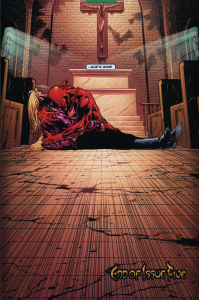
Karen was the second loved one Matt lost to Bullseye and, unlike Elektra, she didn’t come back. Karen’s death deeply affected Matt and he entered what many characters would later suggest was a nervous breakdown—one that was made worse by his secret identity getting leaked to the press and the never-ending court trials surrounding it.
Despite Matt’s personal drama, as Daredevil he became even more obsessed with stopping crime at all costs and grew more aggressive in his efforts. His deteriorating mental state could be seen in his next encounter with Bullseye. He showed a dangerously unstable level of cruelty when he carved a target into Bullseye’s forehead. He even went so far as to suggest that Bullseye should use it to aim and commit suicide.
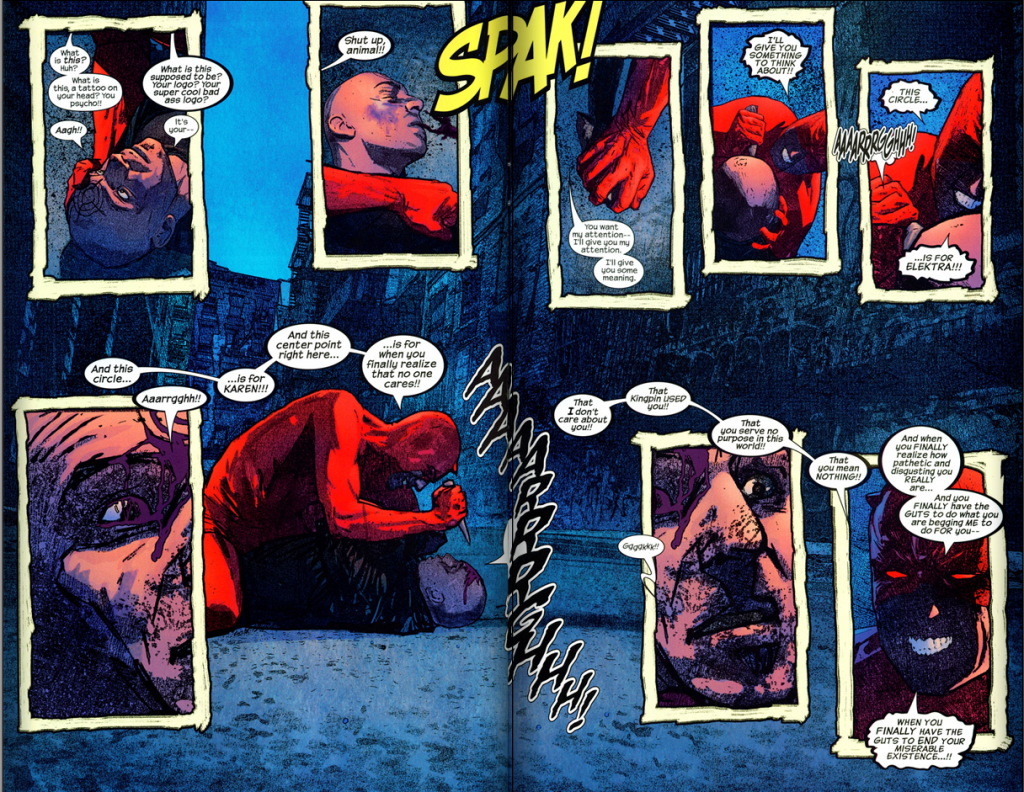
As shocking as it was, it’s hard not to sympathize with Matt, because Bullseye had just made aggressive threats against Matt’s new girlfriend, Milla. However, Matt’s actions could definitely be seen as a man walking a dangerous line.
Shortly after his run-in with Bullseye, he toppled the Kingpin and installed himself as the new Kingpin of Hell’s Kitchen in a rather ill-conceived plan to destroy crime from the inside out.
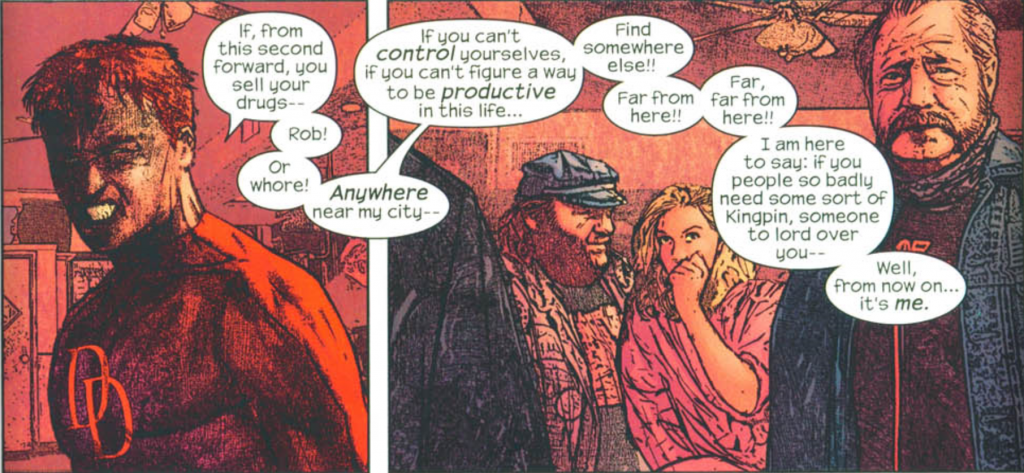
As you can see from the above picture, he stopped attempting to hide his identity and made his declaration unmasked. At this point, Matt Murdock is no longer very concerned with how his actions will affect his ordinary life, and is much more concerned with his war on crime.
Unsurprisingly, given his lack of caution, the cat and mouse game that he’d been playing with the authorities over his identity ended with his arrest and he was sent to Rykers to await trial. His best friend Foggy visited him in prison and, to all appearances, was killed while Matt was forced to listen helplessly. That was the last straw for Matt’s self-control, and he began to ruthlessly take on the other prisoners.
Word of Matt’s behavior while in prison spread quickly and Frank Castle, also known as the Punisher, decided to get into prison to see him. He broke a pimp’s neck in front of a cop and then promptly surrendered, getting himself a ticket straight to Rykers. While there he confronted Matt about his actions, and showed some concern about Matt’s state of mind (coming from the Punisher that says something).
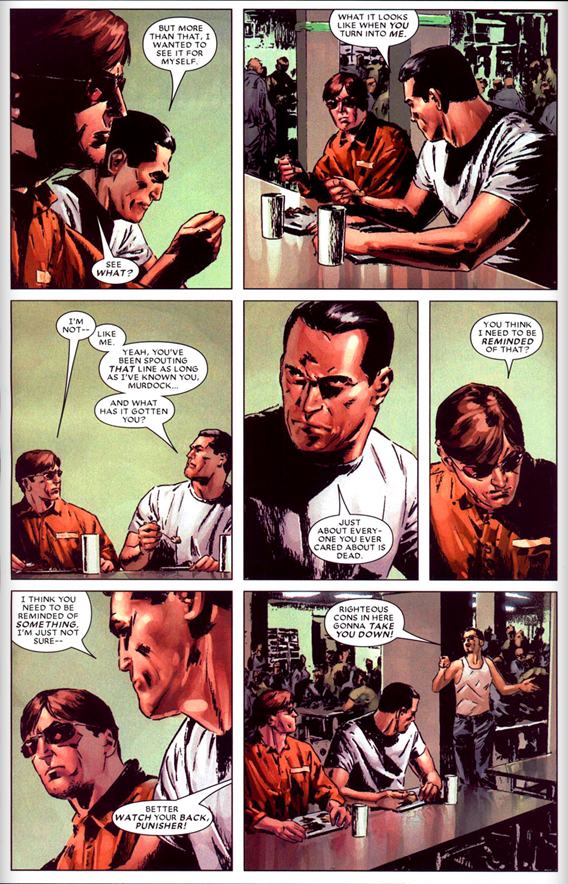
When a prison riot broke out Matt worked with the old Kingpin, Wilson Fisk, to survive and escape, until he found out that Fisk was working with Bullseye too. Working with Bullseye was a line that Matt wouldn’t cross. Instead, he turned to Frank. After they escaped, Frank had a few words of wisdom for Matt, trying to remind him that he doesn’t want to turn into the Punisher.

By using the Punisher, author Ed Brubaker was very clearly showing how far Matt was spiraling. The Punisher is a cautionary tale for what happens to a person who can’t let go of vengeance and hatred and, in this case, even he was concerned for Matt. Historically, Matt had tried to save or stop Frank from his dark path, but at this point Matt was close to walking it too.
Eventually Matt was cleared and he found out that Foggy was still alive, but his life continued to spiral out of control. In a relatively short period of time he received several major emotional blows. Milla, whom he had married shortly before he was arrested, became aware of his unstable mental state and left him. They managed to reconcile, but then she was driven insane by a villain. Afterwards Milla’s parents took over her care, forcing Matt into a divorce that he didn’t want. On top of everything else one of his good friends was shot.
To make everything more complicated, the Hand—a group of dark magic using ninjas—showed up to make his life hell, this time by trying to get him to lead them. Apparently he didn’t learn his lesson from attempting to stop crime by becoming the Kingpin, because he decided to take over the leadership of the Hand in order to try to steer them into the light. Matt grew so unstable that Foggy even went so far as to fire him from their law practice.
It was at this emotionally tenuous time that Bullseye came back into the picture and lured Daredevil out to an apartment building full of people, and then blew it up. He killed 107 people just to taunt Matt, and he told Matt that it was all his fault because he hadn’t killed Bullseye when he had the chance.
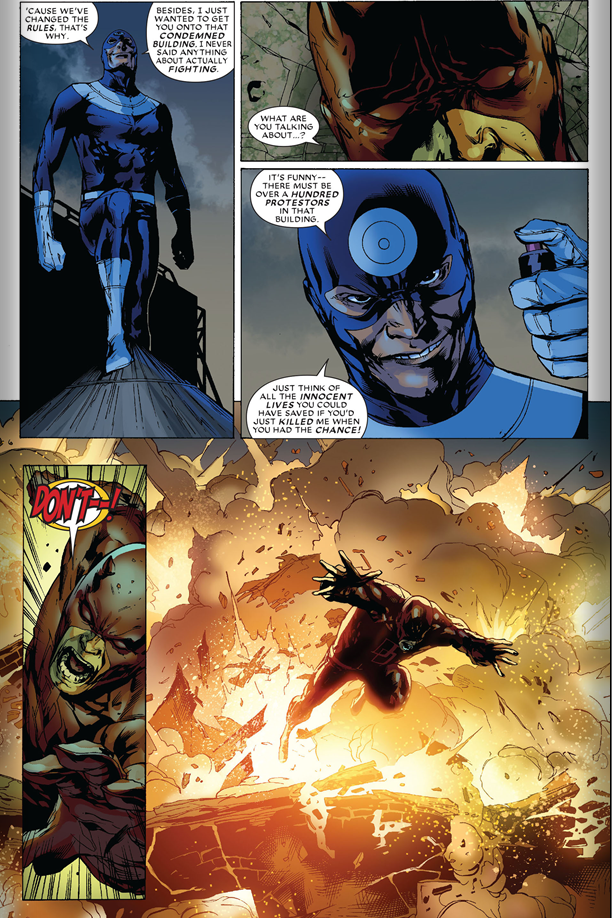
The next time Bullseye sought Daredevil out it went very differently. Matt had finally had enough. Not only had he personally lost so much at Bullseye’s hands, but he had witnessed Bullseye commit mass murder. Worst of all, Matt knew that he could have stopped Bullseye if he had just been willing to take that final step. At this point, his personal life was in shambles and he had left everything behind to become the leader of the Hand. He was isolated and surrounded by ruthless killers day in and day out.
Matt had been pushed over the line and this time when they fought, Matt didn’t hold back. Daredevil, wearing a very symbolic black uniform instead of his normal red, was ruthless. Bullseye was shocked because Matt wasn’t acting the way he usually did, but Daredevil ignored him, breaking both of his arms and then stabbing him through the chest, killing him.
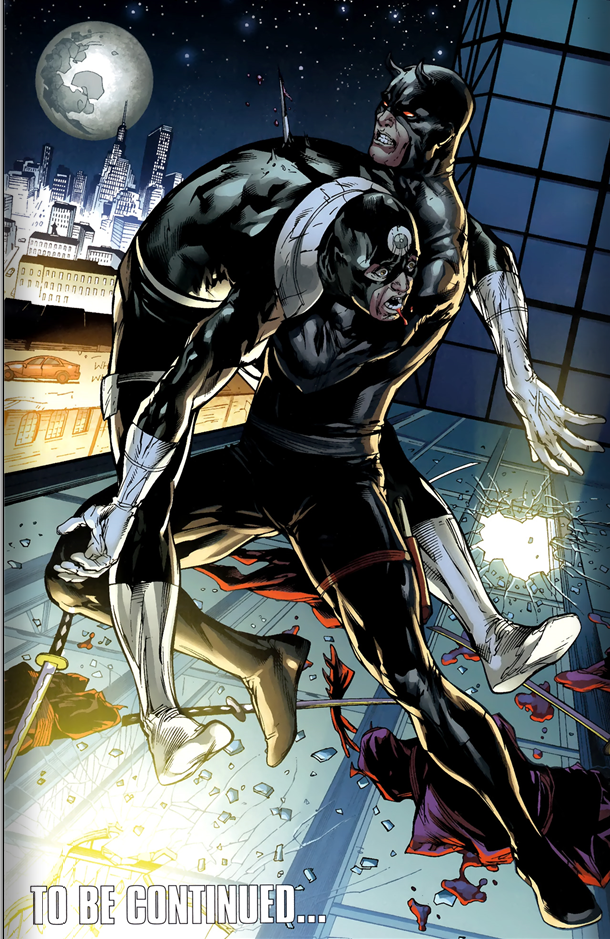
The scene was shocking and unforgiving and eerily reminiscent of the panel in which Bullseye killed Elektra. This was a hero who had been pushed too far and lost too much. This was a hero who had reached his breaking point and finally taken out his arch-nemesis in the same way that his nemesis had killed his lover.
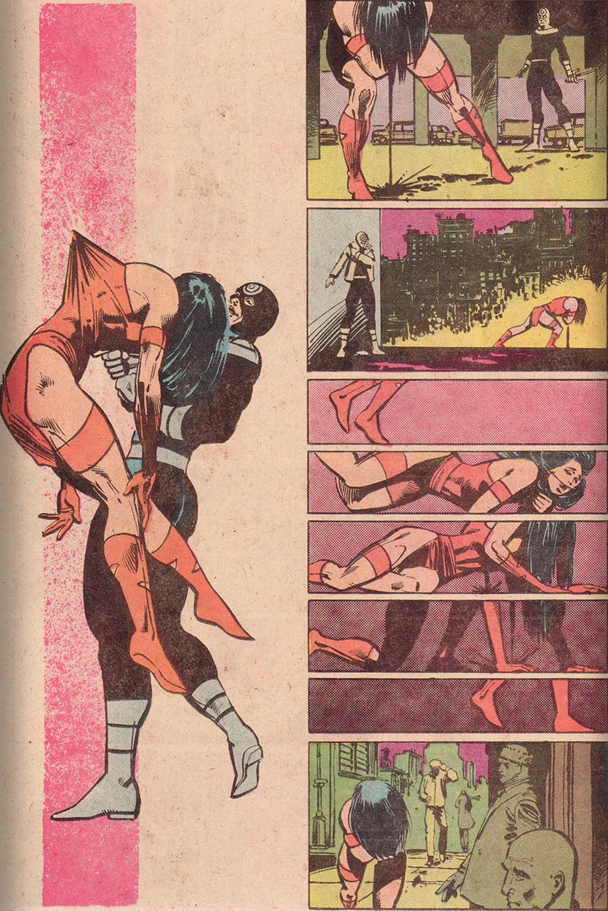
Matt’s actions were shocking to the reader and shocking to his friends in universe. The events were witnessed in person by Luke Cage and Danny Rand (Iron Fist) and were replayed on television for everyone to see.
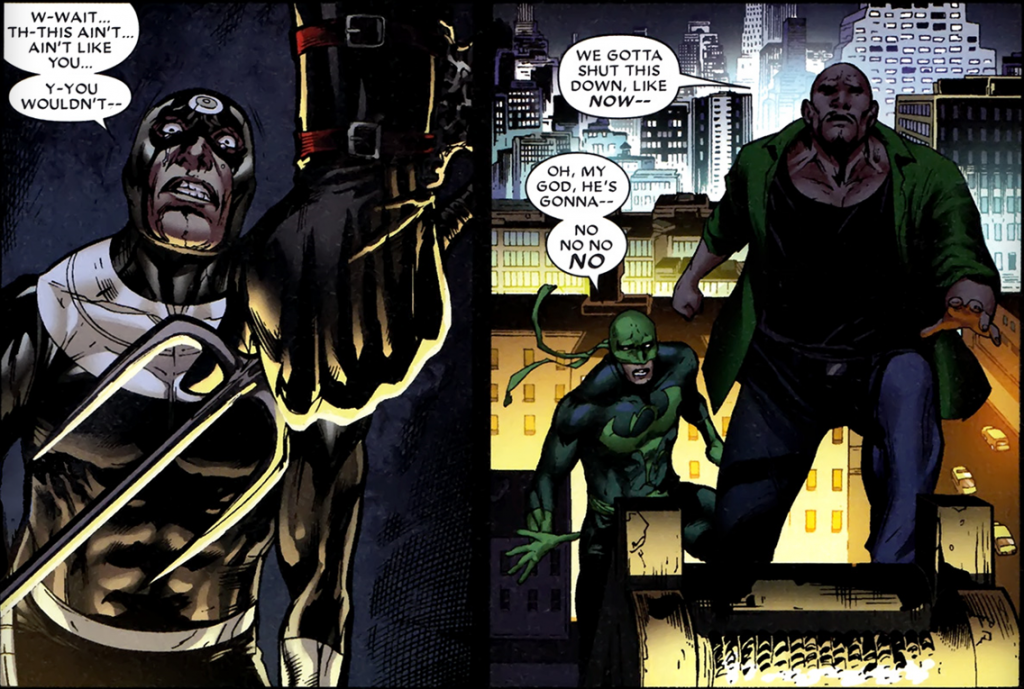
Matt’s friends struggled with what they saw, trying to make excuses for him and trying to find a way to help him. Danny gave voice to a common frustration many readers have when he pointed out how many people Bullseye had killed. Superhero comics start to feel futile when you know that the villain will just escape and kill more people. In that context, it’s hard to fault a hero who finally takes out a villain except, as Luke pointed out, Matt’s actions were cold-blooded murder, and it’s hard to root for that.
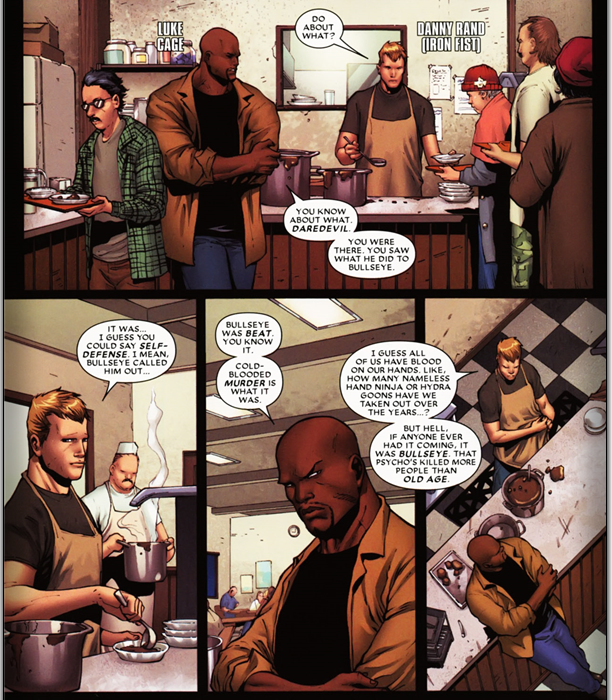
The entire Shadowland event was a symbolic representation of what happens when a good person, stops fighting against the darkness and embraces it. Once he stepped over that line, Matt became submerged in darkness and began using the Hand in increasingly questionable ways. He eventually reached the point where he ordered them to kill at the drop of a hat.
Eventually it was revealed that Matt had been possessed by a demon, and his decent into darkness was reflected in the art as well in the story. He looked less and less human as the event progressed until he was more beast than man.
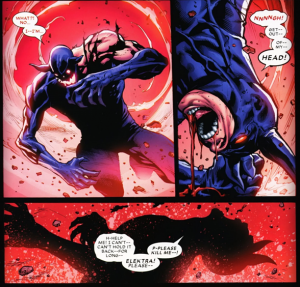
Just when Matt seemed to be entirely lost to the beast, Foggy managed to get through to him and with the help of Danny and Elektra, Matt expelled the demon. But once the demon was gone, Matt had to face the consequences of his actions. It would have been easy to blame the demon for Bullseye’s death, but author Andy Diggle didn’t take the easy way out; he made sure the reader knew that Matt made that choice on his own. In fact, the choice to kill Bullseye was what let the demon take him over in the first place.
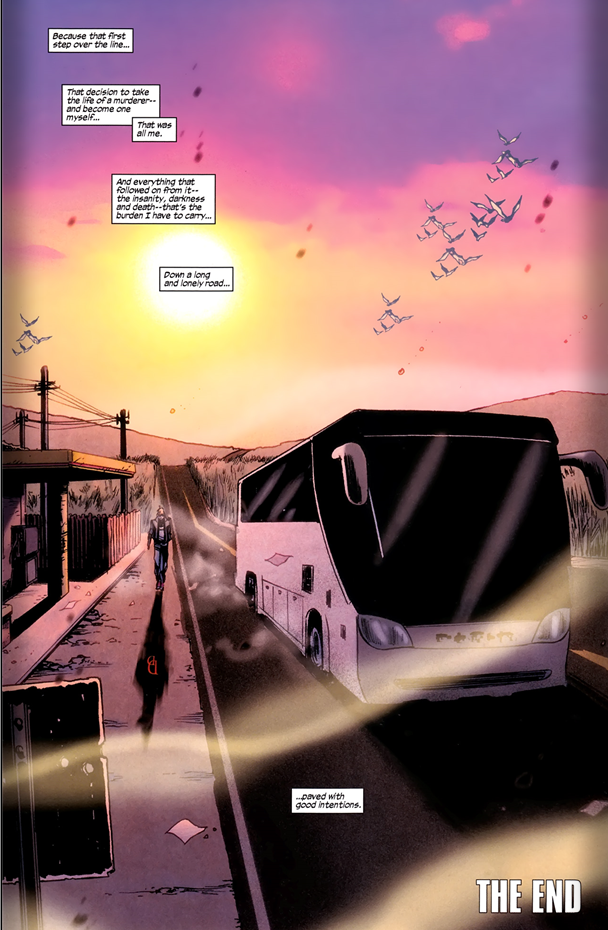
So what happened next? How does a hero recover from the sort of darkness that led him to murder? Matt Murdock is not the Punisher, and he never will be, so what followed the events of Shadowland was a period of reflection and change for the character. Matt had to find a way to deal with his actions, and so did the readers.
The most important thing to Matt, the thing that drives him to put on a costume at night and be a vigilante, is his neighborhood. Hell’s Kitchen is to Daredevil what Gotham is to Batman. Once he’d come back to himself, Matt realized what his actions had done to Hell’s Kitchen. He had turned the Hand loose on his own territory in the worst way. He’d made ordinary citizens fear him and he’d nearly killed his friends.
Struggling to deal with what he’d become, Matt’s first stop was church. Matt was raised Catholic and while for the most part he doesn’t practice, it’s still an important part of his character. The events of Shadowland were enough that he sought confession, saying that it had been “way too long.”
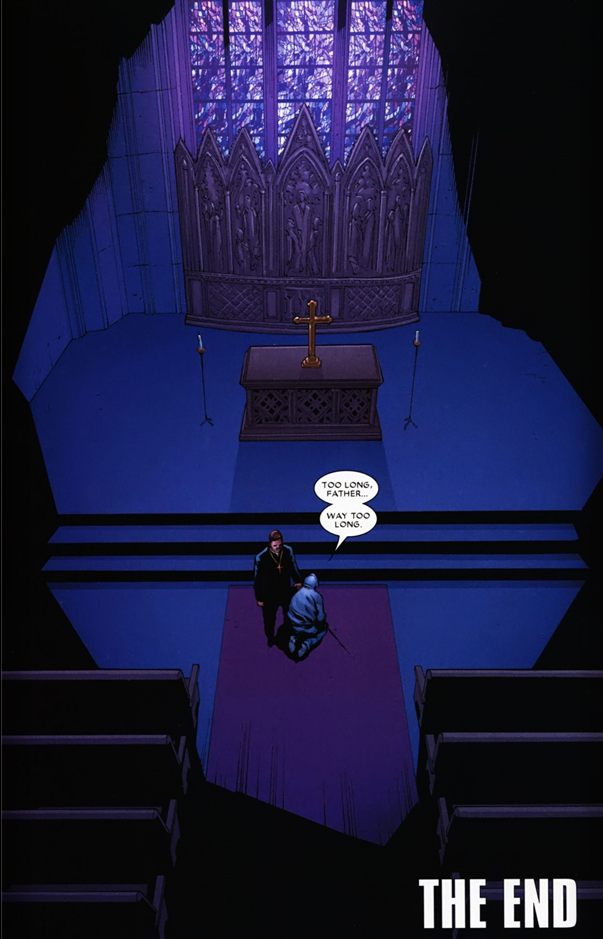
After making his confession, he left town. He didn’t have any plan other than to get away, and that led him to the Southwest. While there he stumbled upon criminal activity, but he refused to get involved, afraid of what he’d become. He even let some thugs beat him up instead of fighting back, because he thought he deserved it…and because he knew that he could kill them. That knowledge frightened him.
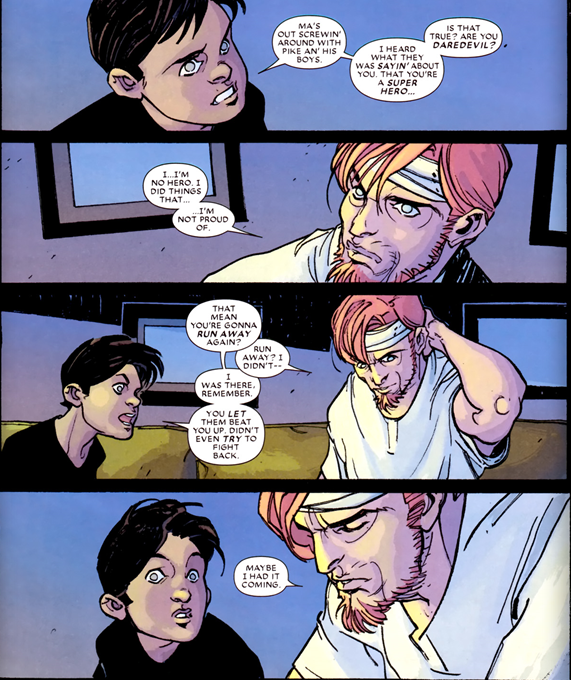
Later, when a young boy confronted him about the thugs, Matt tried to tell him that he wasn’t a hero. He told the boy that he’d done things that he wasn’t proud of and that he deserved the beating, but the boy didn’t agree. He helped Matt see that there were more important things at stake than his own self-pity—like the thugs who that had killed the boy’s father. Matt found out that the entire town was under the thumb of corrupt drug traffickers who were harassing the citizens.
The boy was very purposely symbolic of a young Matt Murdock. He was a blind boy who had recently lost his father because the man had stood up against the criminal corruption in his town. That story could have been cribbed directly from Matt’s own life story and reminded him why he had become Daredevil in the first place. Ultimately, I don’t think it would have mattered whether he saw himself in the boy or not, because Matt is a character who cannot let an innocent suffer if he has the ability to stop it. After Shadowland I think that he needed the reminder. So he set aside his own issues and he went to face the criminals.
Unfortunately for Matt, the criminal in charge had the ability to make a person experience their worst fears. Apparently Matt’s worst fear was the fact that he had enjoyed killing Bullseye, which made him afraid that he was like Bullseye.
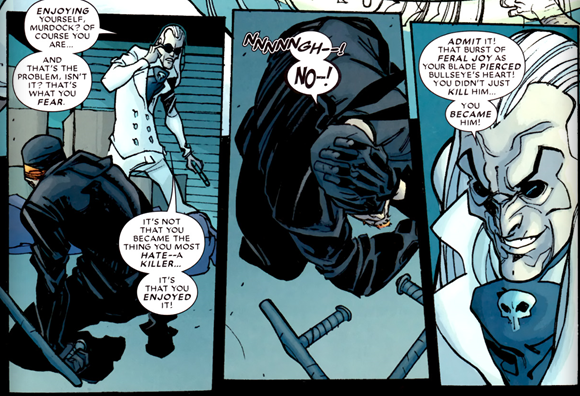
However, Daredevil is known as The Man Without Fear for a reason. Matt is no stranger to facing his fears, accepting them, and then conquering them. His entire super-hero identity is based around being fearless, and this situation was no exception. Matt acknowledged what he’d done and accepted himself, and by doing so, the villain lost his power over him.
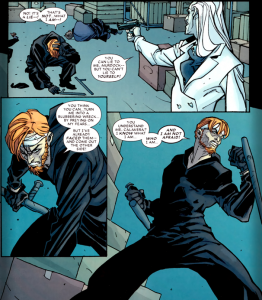
Having come to peace with himself, Matt returned to New York and tried to take up his old life, both personally and as Daredevil. His journey of self-reflection made him decide that from then on he had to live in the now, not worrying about the past or the future, and that he had to be happy. He had to approach life with a smile or he wasn’t going to be able to survive it. He knew that he had lived in the darkness for too long and that his very sanity was at stake, so he decided to try that new approach.
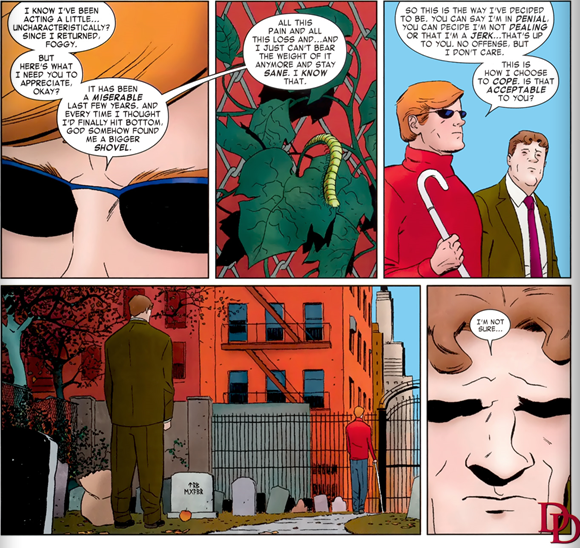
That didn’t mean that things were easy for him. Foggy was worried about his mental state and was afraid he wasn’t coping in a healthy way, and some of the other heroes didn’t trust him. Captain America in particular wanted to arrest Matt for the things that he had done during the Shadowland event, but was persuaded to hold off. Matt was no longer unquestionably a hero in others’ eyes, and would have to continue proving that he deserved a second chance.
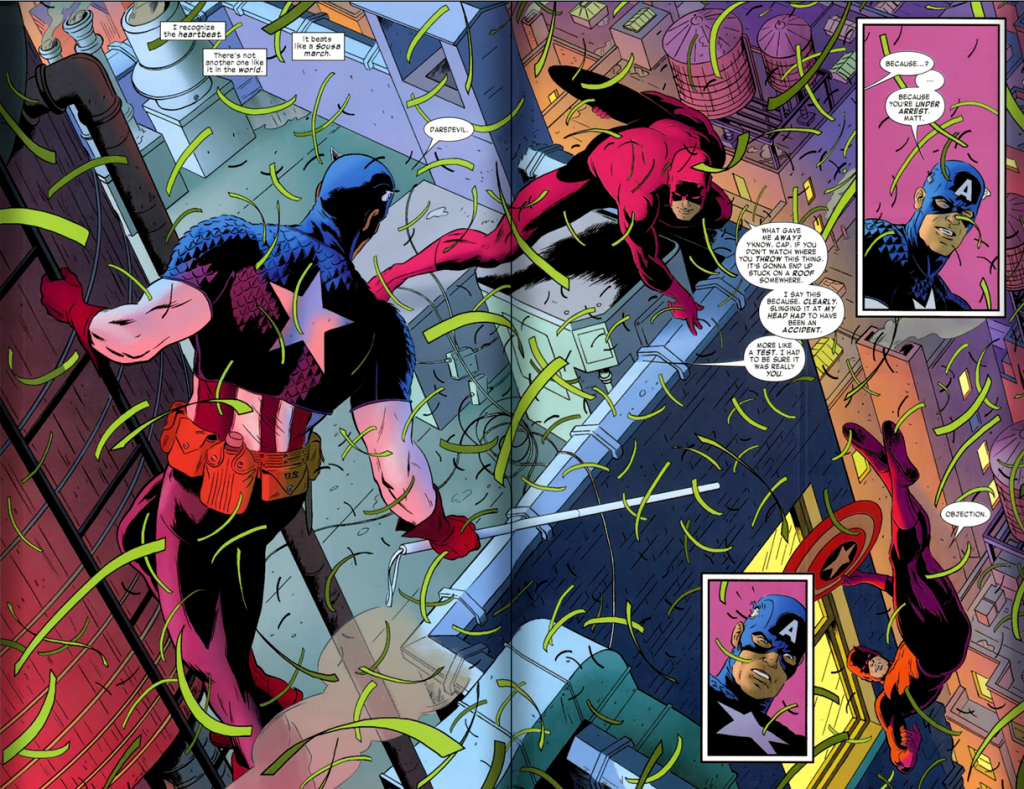
Matt spent quite a bit of time regaining Foggy’s trust and he was lucky he got it, because the first major blow to his new approach to life came in the form of…Bullseye. Yes, that’s right; because this is comics, Bullseye reappeared three years after he died. Thankfully, author Mark Waid didn’t erase his death at Matt’s hands (which would have been the easy, lazy way out), but instead had him resurrected by his loyal follower Lady Bullseye.
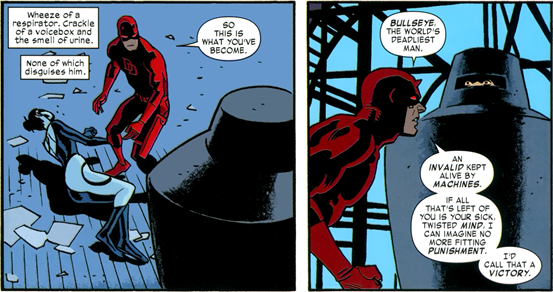
Bullseye returned as an invalid and was forced to take on Daredevil through elaborate schemes. For a long time he was successful at manipulating Daredevil’s life from the shadows, but eventually they met face to face. Matt seemed to show the same unstable reaction to Bullseye when he almost immediately threated to kill him, saying that he had already done it once.
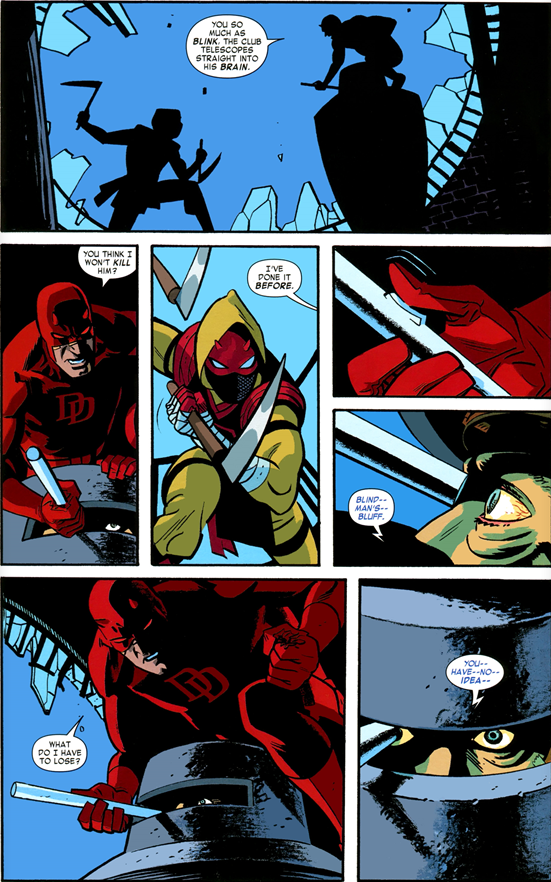
But this time was different. Since he returned to New York, Matt had made a conscious effort not to become isolated (he even joined the New Avengers for a while), and Bullseye’s plan ultimately failed because Matt turned to his friends for help. He was not a lone man up against a wall, and he was in a much more stable place. In fact, Matt even saved Bullseye when the toxic waste he was experimenting with spilled on him.
Bullseye was blinded by the toxic waste which, when added to his paralysis and his deafness from the resurrection, left him no longer a threat (at least until the next time Marvel brings him back). Afterward, Foggy asked Matt if he’d really tried to save Bullseye’s sight, and Matt hesitated before saying that he “did what was right.” It’s left up to the reader to decide what that means.
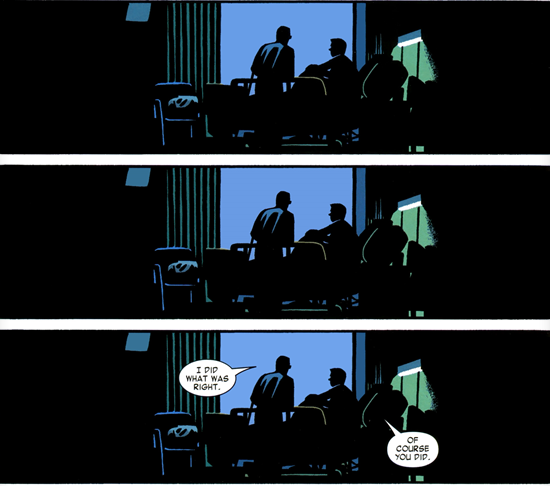
After taking this long journey into the darkness and back with Matt, I believe he did do what was right, and that was to try to save Bullseye from blindness, not just from death. I believe Matt has pulled himself back into the light and is still a hero that can be counted on. I don’t necessarily think that he regrets killing Bullseye specifically, but I do think he values life and justice enough to regret that he killed anyone. Because he has fallen as far as it was possible for him to fall and made it out the other side, it will be hard to push him that far again.
I don’t expect Daredevil’s path to be an easy one, and I know he will face the darkness again. But for now, he has faced the worst in himself and no longer fears it. He can’t change what he did, but he can do better in the future. And I believe he will.
Daredevil is a hero who killed once, but still believes that killing is wrong. Over the course of ten years and four different writers (Brian Michael Bendis, Ed Brubaker, Andy Diggle, and Mark Waid), Daredevil comics have explored what happens when a hero is pushed so far that he finally takes a life. But they’ve also shown us that that doesn’t mean the end. Killing once doesn’t make you the Punisher, and Daredevil is still a true hero.
I covered a lot of Daredevil comics in this article, but here are two good places for a new reader to start if you are interested in Matt Murdock’s story:
Daredevil vol. 4: Underboss. Written by Brian Michael Bendis; art by Alex Maleev. Published 2002; collects Daredevil v2 #26-31. Find it on Amazon or buy it from comixology.
Daredevil vol. 1. Written by Mark Waid; art by Paolo Rivera and Marcos Martin. Published 2012; collects Daredevil v3 #1-6. Find it on Amazon or buy it from comixology.
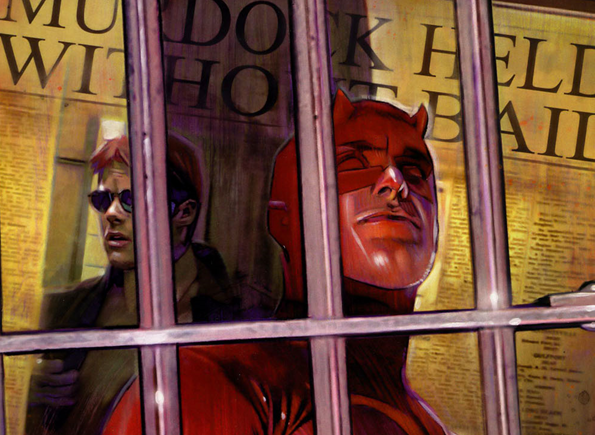
Wow, no wonder Mark Waid started off his run with a much lighter tone – Daredevil had been through the wringer. I definitely appreciate the way the different authors dealt with Daredevil killing someone – it’s always nice when comic writers take the time to make actions have consequences rather than just casualties of heroes and villains.
One of my favorite things about Daredevil is the way the writers have developed him over time in a logical and progressive way. Bendis did an amazing run and Brubaker picked right up and continued it. Then Diggle picked it up and did Shadowland which lost some of the gritty realism of the prior runs but still felt like a natural progression of the darkness in Matt’s life. And then Waid picked it up and while the tone changed there was a very clear reason for it characterization-wise and nothing has been dropped.
I just love that Daredevil of 10 years ago is not the same as Daredevil now, but that it is because of character development and not retconning or rebooting. I am also so glad that they kept the killing in and didn’t try to whitewash it. It is such a defining character moment that provides so much opportunity for character development.
As you can probably tell I am pretty passionate about Daredevil…
Glad you’re passionate about Daredevil – you could be our resident Daredevil expert.
I think, especially because of its failure to go gangbusters at the box office, Daredevil has fallen to an A- or B+ level character and I think that’s been the greatest thing that ever happened to him. I loved Spidey stories all my life, including the last two years before I had to drop it, but he seems to be locked into a much smaller level of growth because he’s too popular a character to allow for character evolution. In fact, that was the stated reason for the marriage reboot – he had evolved away from the pathetic loser dude who couldn’t get a date or was lucky to be dating MJ.
I think my favorite thing about Waid’s run (and I’ve only seen a few issues – I definitely need to buy the Omnibus when he’s done with the character) is the whole “I’m not Daredevil” thing. It’s so great – my favorite gag.
[…] but time and time again Daredevil breaks the mold. The very first article I wrote for this site (To Kill or Not To Kill: Daredevil’s Heroic Struggle) touched on the way Daredevil has been allowed to progress as a character instead of stagnating and […]
Horrible issue and clearly not written by someone who understands the Punisher in the slightest… I miss Garth Ennis…